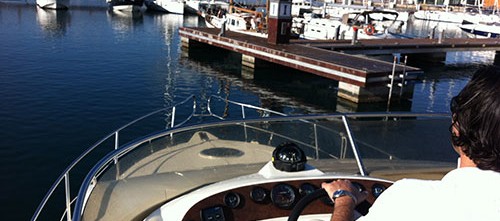Berthing when it’s going wrong
Newsletter Articles
Motor boating is normally a fairly relaxed activity all except for the final bit, berthing. Our previous articles have shown how to choose a berth and what clues to look for. Even with all that knowledge it can still go wrong so here is my view of ways to save the day!
Everybody’s idea of ‘when’ its going wrong differs. Newer boaters tend to think the situation is recoverable far beyond what an experienced skipper does, simply as they have not developed the fear factor or heard the sound of GRP grinding on something. The key as ever is being prepared, so go and practice these tips on a nice day with a bit of space so that you understand what your boat will and won’t do, before you actually need to test it out.
These are based on a twin shaft and bow thruster boat, a twin outdrive with a bow thruster is similar but use of the helm can really help, single outdrives and single shafts require more caution as their relative lack of maneuverability means you have less options.
Key items:
- Carry enough fenders, best of all fender both sides, this alone can make a huge difference. Ball types are good for the bow area on a motorboat.
- If you get it wrong and feel a collision is inevitable then key is to make your boat as stationary fore and aft as possible, sideways movement is hard to stop even with thrusters but if you can halt the fore and aft movement that’s half the battle won. Fenders can take great force with the boat and fender stationary, however, add movement and they can roll out of position.
- Keep the boat’s bow or stern to the elements for as long as possible, it will give you time to assess and work out your plan.
- ‘Slow like a Pro’ with practice you can balance the boat on the elements and keep your actual boat movement really slow. Remember the opposite of “Slow like a Pro’ is ‘Quick like a …….!’
If it’s going wrong?
- It sounds so obvious but if you have worked out fairly early that it’s going wrong the best plan of all is to come back out and try again.
- Be very wary of applying power, unless you are experienced the correct application of power and in which direction is far more likely to cause more problems than actually solving anything.
- If you have ended up close to another boat or an object, put the engines in neutral, the removal of power rarely makes it worse, and provides valuable ‘thinking’ time.
- If you are being blown off your berth too strongly to make it cleanly then your best decision may well be to deliberately land alongside your neighbour. Fendered correctly and stationary fore and aft as you will drift on will do no damage.
- Always be conscious of where the stern of the boat is, the pivot point when going ahead means that if you try to drive away from an object in ahead you are swinging the stern closer.
- If you are getting too close then you may need to push the bow closer still to swing the stern clear. This is really counter intuitive and takes practice. As the stern swings clear, you can reverse smartly away. Once mastered and added to your repertoire you will be delighted.
Bow thruster and engines
Thrusters are great, used carefully at slow speed or stationary they can be a great aid, but overuse can easily cause more trouble.
So the key points are:
- As you thrust the bow one way, the stern will go the other.
- So if close to danger, use the bow thruster combined with the engine closest to the object to move the stern. By short bursts you can crab away from danger.
- At slow speed Starboard ahead and Port astern do the same thing – they move the stern to starboard. So if you combine alternate nudges of Starboard ahead and Port astern with a burst of Starboard bow thruster you can move the whole boat to Starboard.
- The same is true for moving to port so alternating Port ahead and Starboard astern with a burst of Port bow thruster.
- A bit of practice and you can do all three together, so: Starboard ahead and Port astern on their own will induce a turn to Port but if combined from a standstill with the bow thruster to Starboard it will move the whole boat to Starboard.
- The reverse works as well – so Port ahead and Starboard astern combined with bow thruster to Port will move the whole boat to Port.
The key with all these techniques is they need practice, there is no point getting into difficulty and then freezing when you need to be clear headed and positive on how to rescue the boat. So try them out in a reasonable space, and work out how your boat responds and how quickly. Enjoy the practice it will make you a better and more confident boater. Remember we are here to help, if you want one of the team to help you just ask!
